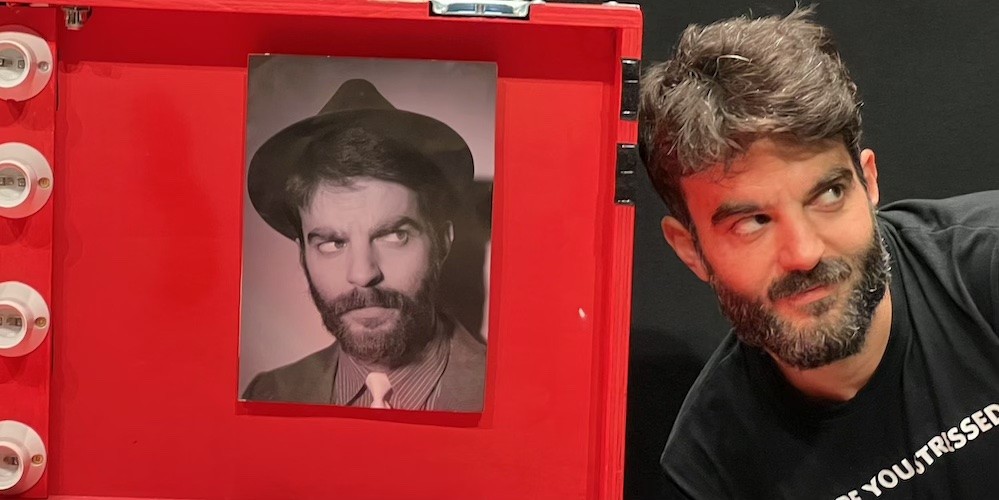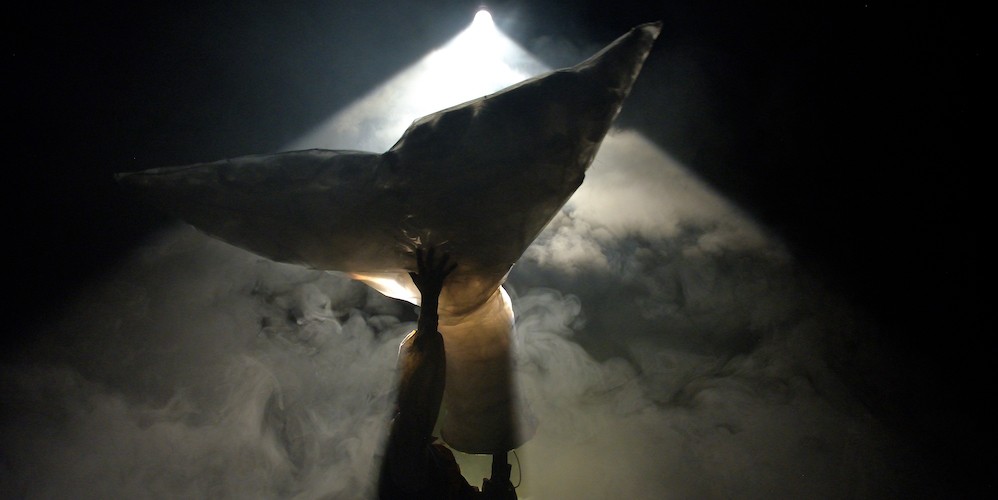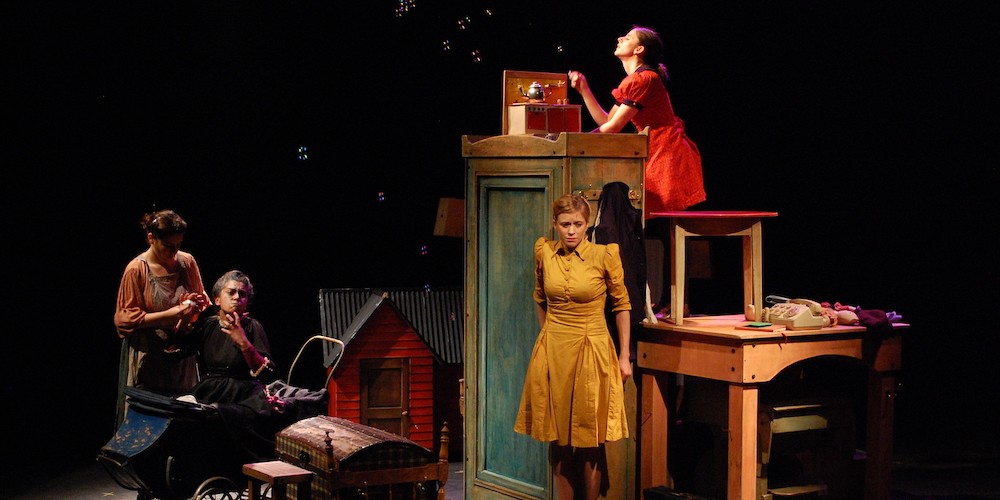Theatre in Motion: The Communicative Powers of Movement and Sound with Miguel Angel Bregante Garcia
In Theatre in Motion, we discuss theatre's movement across stages, through time, and within communities with its creators and practitioners.
We talked about the communicative power of sound, image, and pantomime with Directing student Miguel Angel Bregante Garcia.
Miguel Angel Bregante Garcia was born in Zaragoza, Spain. He earned a bachelor's degree in Telecommunications Engineering from the University of Zaragoza in 2011, and studied in Austria and France thanks to two Erasmus scholarships. He completed a 14 year stay in Santiago, Chile, where he earned a Bachelor's degree in Scenic Studies and specialized in a Lecoq-based Gesture Theatre methodology at the La Mancha International School of Image and Gesture. He worked as a professor of Masked Theatre at DUOC UC University in Viña del Mar, Chile between 2016-2020. He is the Co-Founder and Artistic Director of the Chilean award-winning theatre company, La Mona Ilustre, whose productions have been presented in Chile, Brazil, Argentina, Mexico, Spain, France, Belgium, Norway, Taiwan, Germany, and the United States. He is currently in his second year of the Directing MFA at Columbia University School of the Arts. Garcia speaks English, German and French.
Could you tell me about your personal theatre history? What brought you to theatre in the first place, and what has kept you in it?
Miguel Angel Bregante Garcia: My theatre history starts 27 years ago, in 1996, because I fell in love with a girl that was learning and doing theatre at a youth house. So, I went after her to do theatre. My family background is very scientific. My father is a veterinarian, and my mother is a chemist. We are all very much “number people.” I like physics, I like mathematics, I like numbers. But this, this theatre activity in a youth house, was something completely different. So when I started in this theatre group—which I found really difficult, with the improvisations, the exercises, et cetera—I found a certain amount of epicness that I liked. And when we got to present something at the end of the year, it offered this beautiful moment of belonging.
I think I could be telling this story with any other art or any other activity that involves a group, but theatre is what happened to me. When I started telling my friends, ‘I do theatre,’ my friends that studied at school with me were all like 'really?' (laughs). I thought I was a bit cool doing theatre—it wasn't true, but I still felt that I had to keep going. The girl that I’d been in love with left the theatre group one year later and I stayed. I kept doing amateur theatre for a while with a theatre company called Quia Teatro. All of us in the company were very involved in it because we were friends, so we were just gathering and doing theatre; we could have been gathering and drinking, but instead we were doing and making theatre. We earned some prizes and recognitions. Soon, I jumped into professional street theatre, performing and dancing on stilts a lot.
Then, as I was still a “number person,” I studied engineering, but I kept doing theatre. I had to do some juggling of interests, but I had a drive to keep doing theatre. And when the time came to finish my engineering degree—that I studied for between Zaragoza (Spain), Vienna (Austria), and Lille (France)—I said to myself: I have to keep doing theatre. I have to quit engineering. So, I flew to Chile to study and train in a Lecoq school. I was supposed to stay for two years, but I stayed for 14 because I founded my company, La Mona Ilustre, while I was there. In the company we followed what we were doing in the Lecoq school, which was just creating, creating, creating—working with bodies, working with movement, working with any idea of image. We went for it. We didn't talk a lot; we just went for it. We wanted immediately to have bodies in space. That's what we did at school, and that's what we did at La Mona Ilustre Theatre Company. Over 14 years, we produced seven shows and toured not really half the world, but close: Brazil, Mexico, Argentina, Chile, Spain, France, Belgium, Norway, Germany, Taiwan, and the U.S.
La Mona Ilustre’s show, Juan Salvador Tramoya, recently had its U.S. premiere at Lincoln Center’s Festival of Firsts (under the English title, Juan Salvador Custodian). The piece is unique because the solo performer hardly speaks and primarily uses sound and movement to communicate. Could you tell me about what inspired the piece?
MABG: This story starts when we were touring our first show called Los Peces No Vuelan; we toured in Spain for one year with that show. It was insane. And we decided—which was also quite insane—to create other shows while we toured. Juan Salvador Tramoya came from that time. My friend Diego Hinojosa came to me and said: 'I want to do a show with sounds.' At that time, many people were coming to me saying that they wanted to do a show with this or that, and I discovered that I often didn't believe these people. They might have said they wanted to do a specific show, but it was not really true. The desire didn’t reflect who they were, just what they thought a show could be. I didn’t want to get involved with these kinds of shows. But then this kind of “stupid” premise seemed believable to me because I'd seen Diego making sounds forever. I'd seen Diego barking and dogs answering. I’d seen that; it wasn’t just something that people had told me. He suggested that we could do short sketches, and I said I wasn’t interested in sketches. Let's use the sounds to tell a story. That was all we said before getting into the rehearsal room.
Diego and I both were interested in the idea of the antihero. We originally decided to try to create the quotidian—the day-by-day of an antihero. And we asked: what happens during the night? We thought, perhaps in the night he's sleeping, but there is a mosquito in the room. That’s how we originally started the story: in the darkness with the sound of a mosquito. Then the antihero went and prepared a tea with very detailed miming sounds and gestures. In all, we built 40 minutes of quotidian. Pure miming. Very specific, very well done—because Diego is virtuosic in those skills. And after 40 minutes, we realized that it was not interesting at all. It was technique; pure technique. There was too much space to get distracted—it's difficult to follow an all-mimed story. We started to ask: what are we doing this for? So we looked at it again. And we asked: what is it that he's doing? Why is he using mime? Who is he? What does he want?
By that time, we were living in Zaragoza, touring in Spain. While we were there, we saw a show in a bar. During the show, the performer entered the bar asking people if they’d seen a friend of his. 'Hey, have you seen Gustings? Have you seen Gustings? He's a short guy. No? Okay.' We watched this performer tell us a story from this foundation—from this nothing. He used all his storytelling capacity, and he grounded the story in the bar and in the way we, the audience, followed the story. After seeing this little show, we said to ourselves: that might be it. Our antihero uses the sounds for something. What if this hero is a guy flying away from his reality? His reality is not very good, and maybe he flies away into a great, imaginative world that he builds with his sounds. We decided to set it in a theater, and determined that our antihero wants to do what the artists, or the “stars,” do. But he cannot. Yet, at the same time, he is doing it because we're seeing it—and he's a rockstar. So we started working on the show from this idea, which was anchored on the character and on the audience.
That’s so interesting—I love how such an elaborate story arose from such a unique, though seemingly simple premise. Once the piece started to be built, what was your process of moving it from rehearsal to performance?
MABG: After the story flowed out, we started placing it in a theater for a sort of preview period. But when you go as an audience member to the theater, you think of the space of the theater, the stage, as anything except a theater. So people didn’t understand that our antihero was working in a theater. Our set designer, Eduardo Jiménez—who's a fantastic and wise person and theatre maker—said to us: 'Let's place it in the dressing room.' And from there, our hero can fly away. And he was right; that way, the story was related to a theater, and we see some signs that lead us to know it’s meant to be a theater. With that set change, the show took another step forward.
Then, when we were trying to understand what the title was, we thought of this book—there is a book in Spanish called Juan Salvador Gaviota, which in English is called Jonathan Livingstone Seagull. It’s an allegorical tale about a seagull that forgets to eat because he wants to fly. He likes to fly and fly and fly. And he enjoys flying so much that he forgets everything, and he's rejected by the other seagulls. So, inspired by the name Juan Salvador Gaviota, we named our show Juan Salvador Tramoya. “Tramoya'' essentially means stagehand. There are three sentences that Diego says in performance: 'Why, Juan, why? Why don't you want to be like the others? Why don't you eat?' These three sentences are from the book. The rest has no dialogue, just Diego’s sounds.
Immediately when we premiered it, even the toughest critic in Santiago (Chile) was really into it. And I think it was because it was made by two friends—the best of them. I like to tell stories. I like to put antiheroes on stage. I like to tell people, 'You are unique.' And Diego is completely virtuosic on stage. Our two worlds worked together, we told this story together, and it was pretty emotional.
Can you tell me more about touring the show—its literal movement—around the world?
MABG: I like to say it’s a big-small show, because it's self-contained. It tells a whole story, of course, but it's one person. And with that one person, it's a whole show with different worlds, different spaces, et cetera. The show got pretty good reviews immediately, and we started to tour it pretty easily, also, because the whole set folds up into baggage that can fit in an airplane. We made it like Inspector Gadget; the whole dressing room closes up into easily moveable baggage.
So, when we were touring with La Mona Ilustre’s other shows, we’d bring the Juan Salvador baggage and we'd offer to the venue—wherever we were touring—the option to also present Juan Salvador. Diego was in all the shows, so it was an easy addition. Pretty soon it was all over with our other touring shows, and then it went out alone. We were called to take this show to Germany last November, and we also brought it to the U.S. in October 2022. It moves really easily because it uses only two people. We can do anything; we can tell a very sophisticated plot, but we can do it anywhere. We've done it in remote places in the south of Chile where I was plugging the lights in and out for the effects. And we don't even have to add subtitles because we translate it. It has 30 words. So we translate the words, we learn it together, and Diego goes for it in English, or in Norwegian, or in French, and so on.
What are your goals as a theatre director for the use of nontraditional, nonverbal forms of communication?
MABG: One thing that was told to us when we were training in Lecoq is that when we are kids, we communicate first through our smiles, or cries, or gestures. So there is something about these actions that relates to our childhoods; it's a very primal thing in the body and its gestures and communication. That's something we learn about and are interested in with Lecoq training. I think spoken language is a very, very specific and effective way of communicating. But sometimes it's too specific. Sometimes I don't know what I'm really saying. Of course, there is subtext, and there are many other ways to use words, but sometimes there is nothing better than two people looking at each other and wanting to kiss, you know? You don't always need words. I like to explore these spaces and realize that sometimes words aren’t necessary.
While studying Lecoq, we used to say to ourselves: let's use words when they become better than silence. And sometimes they don't. I think words are incredible—I'm learning that right now—but sometimes life has other layers that are maybe not so incredible, or maybe not so precise or so specific. Sometimes words fix. For example, once when two people were improvising while I was in school, one of them asked, 'What happened to you?' and I just wanted to groan. Don’t ask what happened; just let it happen. There is a lot that can be told without words. And there is a lot of space to involve the audience in what is not told, or in what is only suggested. Not just with the body, but with images, puppets, obstruction, rhythms, lights, sounds. All the elements of theatrical storytelling are equally important. So it's not that we reject the text, it’s that we place it on equal footing with the other storytelling elements. And often what I see is that the text shines much more when it's challenged by choreography or other storytelling elements. I think text is a bit of a static thing, sometimes.
As a theatre goer or an audience member, what do you see onstage that excites you or emotionally moves you?
MABG: What’s human. I'm really into the “small-slash-huge” struggles of the human being. Friendship, loneliness, betrayal, love, rage, astonishment, doubt. I think when a play allows the space for these human things to happen—and this means sometimes allowing for silence, or a shift of rhythm, or so on—I’m interested in it. I think I just place the human over the political or philosophical statement. I don’t think those statements are wrong in theatre, but I’m always suspicious of them. I think we make political statements because we feel lonely, or because we like each other, or because somebody rejected us a moment ago, or something like that. And I'm not saying political or philosophical statements in theatre are wrong and don’t belong there, but I think we are multi-layered people. I like to see the “human layer” all the time. And I’m moved when I get to see the expressive possibilities of theatre stretched to their maximum. This stretching, instead of thinking in a realistic way, is, to me, a way of thinking in a multilayered, poetic way. That mesmerizes me and makes me cry and fly away.



